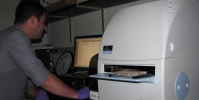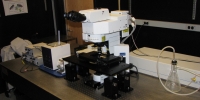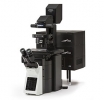Contact Us
Ross Fluorescence Imaging Core
Johns Hopkins University
School of Medicine
720 Rutland Avenue
913S Ross Research Bldg
Baltimore, MD 21205-2195
Phone 410-614-0134
Cell 305-764-2081 George McNamara gmcnamara@jhmi.edu
Director
Prof. Bin Wu
bwu20@jhmi.edu
Associate Director
Prof. Brian O’Rourke
bor@jhmi.edu
(410) 614-0034
Manager
George McNamara, PhD
Image Core Manager, Ross Bldg 913S (Service Corridor)
Ross Fluorescence Imaging Center
http://confocal.jhu.edu
Johns Hopkins University School of Medicine
gmcnama2@jhmi.edu
410-614-0134 office
July 1, 2022: Dr. McNamara is now half-time at Ross Imaging Core and
half-time manager of the High Throughput Phenotypic Screeninfg Platform ("HPS2"), https://mummlab.wordpress.com/research-project-4-drug-screening/
Single molecule Fluorescence In Situ Hybridization (smFISH) Service:
Fatemeh Jahan Bakhsh, PhD
Johns Hopkins University School of Medicine
Biophysics and Biophysics and Biochemistry Department
|
George McNamara Image Core Manager |
Prof. Bin Wu Image Core Director |
Prof. Brian O'Rourke Image Core Associate Director |
Prof. Mark Donowitz NIH P30 DDBTRCC Center Director |
 |
 |
 |
 |
|
Olympus Imaging Center (hosted by our core, Ross Bldg S910) Bo Faust, Ph.D. Lauren Robertson Jason Brenner |
|
Leica team: Paula Maguire, PhD - confocal sales ... was first author of one of the best reviews on fluorescent proteins, https://pubmed.ncbi.nlm.nih.gov/27240257 Sarah Crowe - tech and applications support Peter Franklin (Cytiva product line and Leica widefield etc) Jessica Calafati - Regional manager Geoff Daniels, Manager, Confocal Business Development, Geoff.Daniels@leica-microsystems.com |
|
Nikon team: Stan Midy, sales (Esther Keisermann moved to another role at Nikon) Andrew Ziman, PhD Jesse DeWitt |
|
Zeiss team: Jennifer Malloy Alma Arnold |
|
Cameras: Hamamatsu - Butch Granada |
| * special thanks to John Gibas - the manager of the image core prior to George McNamara's arrival. John is now (1/2022) an independant consultant. |
| * George can supply contact details. Happy to add additional vendors. |
We thank all our vendors for help. Please see http://confocal.jhu.edu/vendors-contact-information for more vendors contact information.
Acknowledging our image core
Please include our NIH 5P30DK089502 center grant number in the Acknowledgements or Funding Sources section of your manuscripts.
For example:
" ... P30DK089502 (to Hopkins Digestive Diseases Basic and Translational Core Center) ...".
Please send us all your publications that use and acknowledge our imaging core! Ideally an email with the reference(s) in text and PDF attachment.
Here is a narrative (now somewhat out of date) about our core:
5P30DK089502-07
P30 grant Core B-Imaging - Olga Kovbasnjuk, Hopkins Digestive Diseases Basic and Translational Core Center (DDBTRCC)
http://grantome.com/grant/NIH/P30-DK089502-07-7316
Abstract
The DDBTRCC Imaging Core B is designed to provide our Research Base investigators. equipment for and instruction and assistance in use of multiple levels of classical and cutting edge fluorescence microscopy and electron microscopy (EM) techniques for study of the physiology and cell biology of GI track epithelial cells at the level of organs, tissues, cell models, and sub-cellular organelles. These include confocal and multiphoton confocal microscopy with applications for intracellular pH and Ca2+ measurements and protein trafficking at a single cell level, FRET microscopy for detection of protein-protein interactions in in vitro and in vivo models, FRAP microscopy for monitoring the changes in protein mobility due to the changes in protein complexes, and META spectral imaging for more than 4 fluorophores. The Core also offers ratio-excitation imaging systems of single cells (microscope/camera based) or groups of cells (fluorimeter) for quantitative measurements of ion concentrations in polarized epithelial cells or in non-polarized cells and a cooled CCD camera for documenting histologic slides. Core B has expanded the repertoire of microscopy imaging techniques by being awarded a SIG (collaboration with JHU Imaging Core) to bring super resolution technology to JHU. Additionally, we developed a partnership with industry and opened an Olympus Equipment Demonstration Center, to provide access to Center members of advanced Olympus microscopy equipment which already includes confocal-in-a- box technology for long time (days) live tissue imaging and advanced TIRF microscopy. Core B also assists DDBTRCC investigators in preparation of intestine, liver, pancreas, and kidney for EM imaging and data interpretation. Since the Center was funded in 2011, the Imaging Core has provided services to 44 current and previous Center investigators, 37 Members and 7 Associate Members and contributed to 76 publications.
Public Health Relevance
Imaging Core B: Narrative The DDBTRCC Imaging Core B is designed to provide our Research Base investigators equipment for and instruction and assistance in use of multiple levels of classical and cutting edge fluorescence microscopy and electron microscopy (EM) techniques for study of the physiology and cell biology of GI track epithelial cells at the level of organs, tissues, cell models, and sub-cellular organelles.
*****
The Leica SP8 confocal microscope is owned by Anesthesiology and Critical Care Medicine (ACCM) and managed by us. If your project(s) on the Leica SP8 are "pretty much self sufficient" please acknowledge ACCM. If you obtained substantial help from our core (ex. from George McNamara), please acknowledge both ACCM and our P30 grant number.





